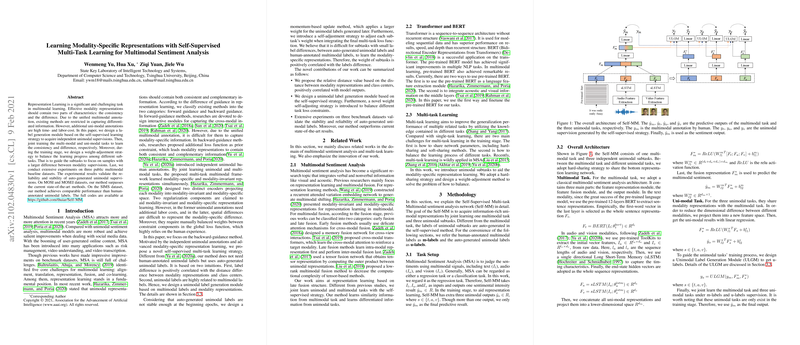An Examination of Modality-Specific Representations in Multimodal Sentiment Analysis through Self-Supervised Multi-Task Learning
In the domain of Mixed-Modal Sentiment Analysis (MSA), one enduring challenge is effectively learning modality-specific representations that encapsulate both consistent and distinctive features of each modality. The paper by Wenmeng Yu et al. addresses this problem through a novel approach employing self-supervised multi-task learning to generate unimodal annotations automatically. This methodology serves to learn both the consistency between modalities and the individual characteristics of each modality without requiring additional labor-intensive human annotations. Furthermore, the paper makes substantial contributions to the field, particularly in terms of surpassing existing performance benchmarks on several datasets.
Methodological Approach
The authors introduce a unified framework termed Self-MM, which jointly optimizes a multimodal task alongside three unimodal tasks. Self-MM is designed to capture the nuanced differences in modality-specific information without the necessity of human-annotated unimodal labels, leveraging automatically generated labels instead. The automatic generation module operates on two principles: the correlation of label differences to distance differences between modality representations and class centers, and the association between unimodal and multimodal labels. With this configuration, Self-MM estimates unimodal labels through a calculated shift from multimodal labels, allowing unimodal tasks to focus where modality-specific divergences are most significant.
Experimental Results
The authors validate their approach with extensive experiments on prominent datasets—MOSI, MOSEI, and SIMS. These datasets encompass a diverse range of multimodal sentiment data, making them suitable for evaluating the efficiency and robustness of the proposed methodology. Self-MM demonstrates notable performance gains over previously reported benchmarks on the MOSI and MOSEI datasets. Specifically, while utilizing BERT for feature extraction, Self-MM sets new state-of-the-art results in several key performance metrics, including MAE, correlation, and binary classification accuracy (Acc-2). It is particularly significant that the method achieves competitive results across both aligned and unaligned data settings, showcasing its robustness.
Insights on Modality-Specific Representation
The paper emphasizes backward-guidance methods over forward approaches by using automatically generated labels to guide each modality's learning process. This approach is backed by empirical evidence showing that the model can achieve a balanced contribution from each modality without explicit prior constraints, such as those imposed by handcrafted loss functions or manually balanced weights. The findings suggest that such self-supervised approaches can significantly reduce the labor costs associated with multimodal sentiment analysis while still providing rich, deep representations at the modality-specific level.
Implications and Future Directions
The implications of the paper extend beyond MSA to the broader field of multimodal representation learning, offering a framework that alleviates the burden of label acquisition and focuses on the intrinsic properties of modality data. The results reinforce the potential of self-supervised learning, highlighting its applicability in scenarios where obtaining exhaustive unimodal annotations is both costly and impractical.
Future work, as suggested by the authors, should delve into end-to-end model architectures that natively incorporate the proposed balanced learning between multimodal and unimodal elements. Analyzing how finer granularity in audio and visual feature extraction within such networks could further refine the model's efficacy, stands as a promising direction.
In conclusion, this paper contributes a meaningful advance within multimodal learning, supplying a strategically simplified yet effective method for enhancing modality-specific representations in sentiment analysis tasks. By mitigating the reliance on costly annotations and achieving superior performance levels, the proposed Self-MM framework establishes a sturdy foundation for future explorations in self-supervised modality representation learning.
